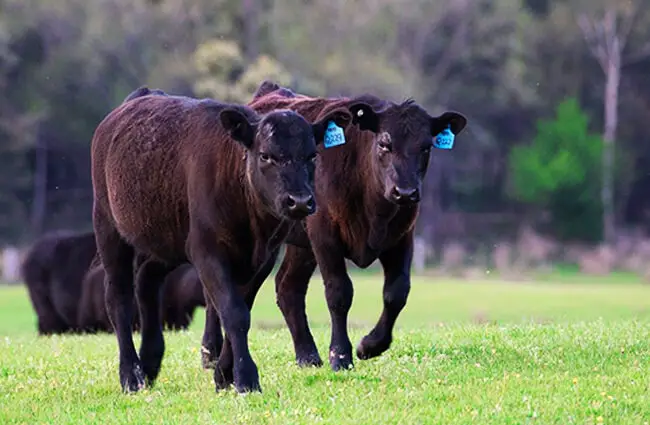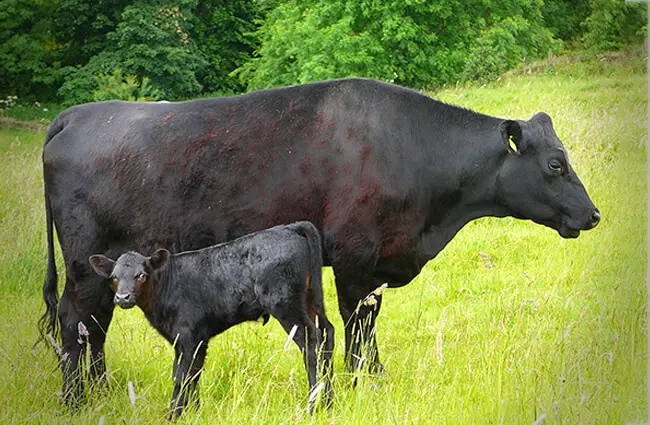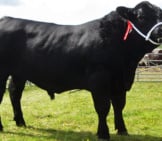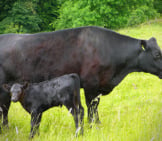The Black Angus is a breed of domestic cow. Researchers classify domestic cattle with the scientific name Bos primigenius Taurus.
All breeds of domestic cattle are members of the Bovidae family. Other members of Bovidae include bison, sheep, buffalo, antelope, impala, and more. Researchers believe that our domestic cattle descended from the wild aurochs, which is now extinct. Read on to learn about the Black Angus.
Description of the Black Angus
This breed is a large hoofed mammal, with a black colored coat. It has a thick, muscular body that people harvest for meat. Males grow larger than females, with the average male, or bull, weighing about 1,800 lbs. and the average female, or cow, weighing about 1,200 lbs.
Interesting Facts About the Black Angus
This breed has a number of interesting traits and characteristics. Learn more about what makes this cow unique, below.
- Polled – Unlike some cattle, this breed does not grow horns. People refer to cows (and goats) that naturally lack horns as “polled.”
- Crossbreed – Because these creatures naturally lack horns, many farmers cross breed the angus with other breeds to produce calves who also lack horns.
- A Degree Above – People generally prefer the meat of this breed over some other cattle. Certified Angus typically has high fat, known as marbling, in the meat, giving it a desirable flavor and texture.
- High Demand – In fact, their meat quality is so superior that this breed is one of the most popular in the world. They are one of the top selling breeds in the world.
Habitat of the Black Angus
People bred this strain of cattle from domestic cows. For this reason, they have no “natural” habitat. People keep these animals on manmade and managed properties with grass for them to eat. Nowadays, cattle live in pastures and ranges of open area. As long as they have lots of space and plenty of grass, these creatures thrive.
Distribution of the Black Angus
This breed originates from domestic cattle, and thus does not have a wild distribution. People originally developed this breed in Aberdeen, Scotland. They quickly gained popularity and spread throughout the country. You can find these animals virtually worldwide thanks to the people that breed them.
Diet of the Black Angus
Cattle are herbivores, which means they only eat plants. As herbivores, they primarily graze for grass, rather than browse on plants and shrubs. They spend part of their day grazing, and the other part resting and re-chewing the food they just ate. They regurgitate their food, or cud, and chew it to aid digestion.
Black Angus and Human Interaction
As domestic animals, this breed would not exist without human interaction. People selected naturally hornless cattle with rapid muscle growth and high-quality meat, breeding only the best-quality animals. Over time, they developed this breed.
People use this cow primarily as a source of beef. Its meat is one of the most popular across the globe.
Domestication
People originally bred this strain of cattle in Aberdeen, Scotland. The development of the breed began in the 1800s and quickly gained popularity. You could find these cattle in the surrounding countries by the mid-20th century. From there, this breed spread across the globe.
Does the Black Angus Make a Good Pet
People did not develop this breed as a pet. Though some have friendly dispositions, the breed as a whole was developed for the purpose of meat production. Most people keep these cows for that purpose, and not as pets.
Black Angus Care
These animals require extensive care and space, because they are quite large. They are social animals, so must live in groups, and those groups must have lots of acreage to roam.
They need lots of grass to eat, and additional hay to supplement their diet if the grass is not optimal, especially in winter. The more cattle on a pasture, the more acreage you need to sustain them.
Behavior of the Black Angus
Like all cattle, these animals have diurnal behavior, and display the most activity during the day. They live in herds, and have social hierarchies of more dominant and less dominant animals.
The cattle at the top of the “totem pole” vary based on age, size, and gender. Herds of cattle spend much of their time foraging for food, and then resting while they chew that food a second time as cud.
Reproduction of the Black Angus
Cattle are polygamous, and a single male breeds with many different females in his herd. After breeding, females have a 9-month gestation period before giving birth to a single calf or twins. The calf can stand soon after birth, and quickly begins walking and following its mother.
The mother weans the calf off her milk when it is about 6 months old. By the time the calf is a year old they are fully independent from their mother. At a year old they reach sexual maturity and can reproduce.

!["Mmm, nom nom nom – this is pretty good!" These Black Angus cows are grazing on organic pastures Black Angus cows are grazing on organic pastures Photo by: Photo by: U.S. Department of Agriculture [public domain] https://creativecommons.org/licenses/by/2.0/](https://animals.net/wp-content/uploads/2020/03/Black-Angus-2-650x425.jpg)

![Who ya lookin' at? Curious Black Angus steer Curious Black Angus steerPhoto by: U.S. Department of Agriculture [public domain]https://creativecommons.org/licenses/by/2.0/](https://animals.net/wp-content/uploads/2020/03/Black-Angus-4-650x425.jpg)

![Hold still everyone! Say "That's our cheese!" A herd of Black Angus A herd of Black Angus Photo by: Photo by: U.S. Department of Agriculture [public domain] https://creativecommons.org/licenses/by/2.0/](https://animals.net/wp-content/uploads/2020/03/Black-Angus-5-650x425.jpg)

!["Mmm, nom nom nom – this is pretty good!" These Black Angus cows are grazing on organic pastures Black Angus Cows Are Grazing On Organic Pastures Photo By: Photo By: U.s. Department Of Agriculture [Public Domain] Https://Creativecommons.org/Licenses/By/2.0/](https://animals.net/wp-content/uploads/2020/03/Black-Angus-2-162x141.jpg)

![Who ya lookin' at? Curious Black Angus steer Curious Black Angus Steerphoto By: U.s. Department Of Agriculture [Public Domain]Https://Creativecommons.org/Licenses/By/2.0/](https://animals.net/wp-content/uploads/2020/03/Black-Angus-4-162x141.jpg)

![Hold still everyone! Say "That's our cheese!" A herd of Black Angus A Herd Of Black Angus Photo By: Photo By: U.s. Department Of Agriculture [Public Domain] Https://Creativecommons.org/Licenses/By/2.0/](https://animals.net/wp-content/uploads/2020/03/Black-Angus-5-162x141.jpg)

![Red Angus Closeup of a beautiful Red Angus cowPhoto by: U.S. Department of Agriculture [pubic domain]https://creativecommons.org/licenses/by/2.0/](https://animals.net/wp-content/uploads/2020/03/Red-Angus-4-238x178.jpg)












![Red Angus Closeup of a beautiful Red Angus cowPhoto by: U.S. Department of Agriculture [pubic domain]https://creativecommons.org/licenses/by/2.0/](https://animals.net/wp-content/uploads/2020/03/Red-Angus-4-100x75.jpg)

